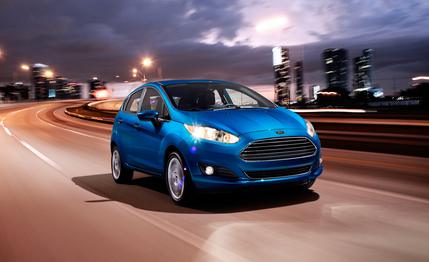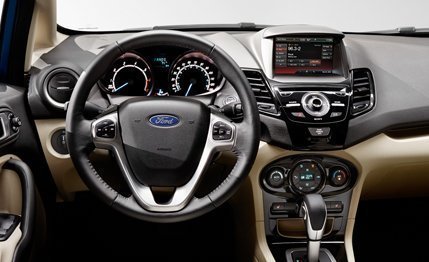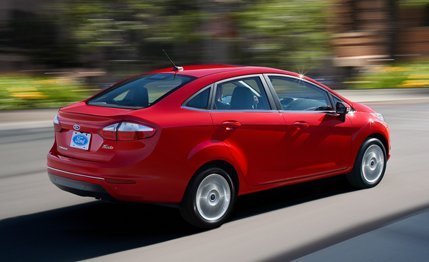
 First Drive Review
First Drive Review
Not long ago, folks probably would have laughed you unconscious if you told them Ford would paste an Aston Martin grille on a subcompact. Today, with Ford design getting ever more attractive—borrowed supercar styling cues be damned—the idea’s not really that zany. Receiving its first mid-cycle update since its introduction in 2010, the Fiesta gets Ford’s latest corporate grille and signature squinty headlights for 2014, as well as a few new technologies to keep things fresh.
Although Ford largely left the Fiesta’s mechanicals alone, there is a new engine option, a turbocharged 1.0-liter three-cylinder, as well as the sporty five-door ST model with a 197-hp, 1.6-liter turbocharged four and six-speed manual. We’ve already driven both, the Fiesta 1.0L in nearly production-ready prototype form and the ST in European spec. This review therefore focuses on the volume engine, a naturally aspirated 1.6-liter four that makes the same 120 horsepower and 112 lb-ft of torque as it did last year.
Touch MyAstonMartin?
In lieu of chassis, suspension, or steering upgrades, Ford’s refresh zeroed in on bringing the Fiesta’s looks up to date. A new hood, front fascia, and headlights bring Mini Me Fusion styling to the front end, and the sedan and hatchback both get new taillights. Last year’s S, SE, and Titanium trim levels carry over, and the standard equipment Ford added for 2013 applies for 2014, as well.


Inside, the center stack has been slightly recontoured to accept Ford’s MyFord Touch touch-screen infotainment system, previously unavailable on the littlest Ford. MyFord Touch is optional on SE models and standard on Titaniums, and it’s scaled down slightly from the eight-inch screen size used elsewhere in Ford’s lineup to a Fiesta-appropriate 6.5 inches. Unfortunately, MyFord’s on-screen graphics and buttons are simply scaled down to fit the smaller screen, meaning the system’s tiny buttons are even more so here, and they’re still tightly grouped and slow to respond. Even worse, the screen is located several inches beyond arm’s length, meaning manipulation of the display requires a forward lean—and a brow-furrowing level of concentration—that might have onlookers thinking you’re lifting a cheek to expel gas. Such embarrassment isn’t limited to the driver—the front passenger also must stretch to use the small screen.
Clutching for Dry Dual Clutches
The Fiesta drives pretty much exactly as it did before, meaning quietly and with a refined, substantial feel that belies its small footprint. Ford reengineered some of the dashboard sound-deadening material and added some noise-quashing pads around the transmission tunnel, so the Fiesta remains hushed on the highway. The suspension strikes an even balance between firm roadholding in corners and well-damped compliance over brutal Michigan pavement.
When the Fiesta was launched, we criticized the optional Powershift six-speed dual-clutch automatic for its slow, unpredictable gearchanges and laggy response. For 2014, Ford addresses the issue with all-new software mapping and reduced friction for the transmission. Although it still doesn’t come close to matching the excellence of Volkswagen/Audi’s dual-clutch design, it is better than before. Shifts felt snappier, and requests for downshifts were met with more urgency.


Also new this year is a manual shift mode that is operated via a very unsporty toggle switch on the side of the shift knob, as well as an “S” sport mode. Neither of the new transmission functions will pull at enthusiasts’ heartstrings, and the S mode’s programming seems designed to delay upshifts rather than make them sportier. The base five-speed manual again is the transmission to get if you’re concerned with maximizing the Fiesta’s meager forward thrust. The shifter has nice action, and the clutch pedal is progressive and well weighted.
We’ve already covered the updated Fiesta’s pricing, which increases slightly, and now Ford has revealed final fuel-economy numbers for the 2014 sedan and hatchback. Both body styles are again EPA rated for 29 mpg in the city and 39 mpg on the highway with the automatic. Strangely, manual-equipped models are downgraded from 29/39 to 27/38. A Ford rep told us the decrease is attributable to testing variations between the automaker and the EPA. It’s a much better story, however, with the optional Super Fuel Economy trim level; the 2013 version was good for 29/40 mpg, and the 2014 Fiesta SFE gets a 30/41 estimate.
As mid-cycle refreshes go, the Fiesta’s changes result in substantially improved looks and a more upscale feel. The Fiesta is still not as engaging to drive as the (aging) Honda Fit or Mazda 2, but Ford’s smallest matches up better than ever against the mainstream, commuter-friendly Chevrolet Sonic and Kia Rio5.